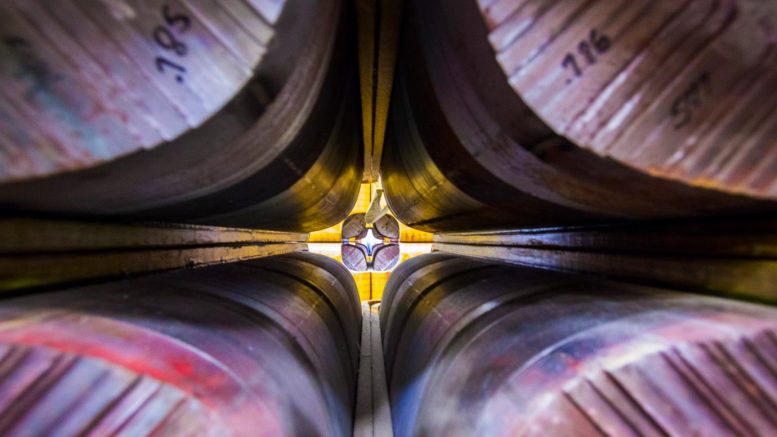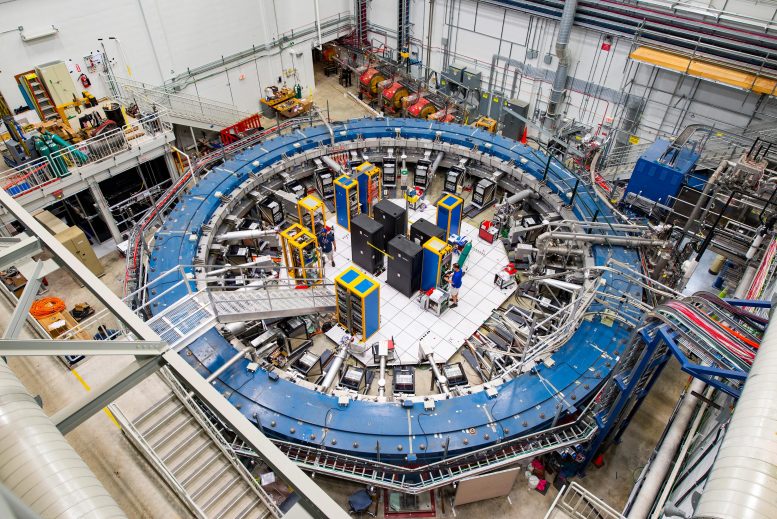Muon g-2 Experiment Results – Profound Implications for the History of the Universe

Peering down a row of magnets leading to the particle storage ring at Fermilab’s Muon g-2 experiment. The results have theoretical physicists around the world frantically working through ideas for explanations. Credit: Photo by Cindy Arnold/Fermilab
Experiment opens up field for new physics, say Fermilab, UChicago scientists.
The news that muons have a little extra wiggle in their step sent word buzzing around the world this spring.
The Muon g-2 experiment hosted at Fermi National Accelerator Laboratory announced on April 7 that they had measured a particle called a muon behaving slightly differently than predicted in their giant accelerator. It was the first unexpected news in particle physics in years.
Everyone’s excited, but few more so than the scientists whose job it is to spitball theories about how the universe is put together. For these theorists, the announcement has them dusting off old theories and speculating on new ones.
“To a lot of us, it looks like and smells like new physics,” said Prof. Dan Hooper. “It may be that one day we look back at this and this result is seen as a herald.”
Gordan Krnjaic, a fellow theoretical physicist, agreed: “It’s a great time to be a speculator.”
The two scientists are affiliated with the University of Chicago and Fermilab; neither worked directly on the Muon g-2 experiment, but both were elated by the results. To them, these findings could be a clue that points the way to unraveling the last mysteries of particle physics—and with it, our understanding of the universe as a whole.

The Muon g-2 ring sits in its detector hall amidst electronics racks, the muon beamline, and other equipment. This impressive experiment operates at negative 450 degrees Fahrenheit and studies the precession, or “wobble,” of particles called muons as they travel through the magnetic field. Credit: Reidar Hahn/Fermilab
Setting the Standard
The problem was that everything was going as expected.
Based on century-old experiments and theories going back to the days of Albert Einstein’s early research, scientists have sketched out a theory of how the universe—from its smallest particles to its largest forces—is put together. This explanation, called the Standard Model, does a pretty good job of connecting the dots. But there are a few holes—things we’ve seen in the universe that aren’t accounted for in the model, like dark matter.
No problem, scientists thought. They built bigger experiments, like the Large Hadron Collider in Europe, to investigate the most fundamental properties of particles, sure that this would yield clues. But even as they looked more deeply, nothing they found seemed out of step with the Standard Model. Without new avenues to investigate, scientists had no idea where and how to look for explanations for the discrepancies like dark matter.
Then, finally, the Muon g-2 experiment results came in from Fermilab (which is affiliated with the University of Chicago). The experiment reported a tiny difference between how muons should behave according to the Standard Model, and what they were actually doing inside the giant accelerator.
What is a muon, and how does the Muon g-2 experiment work? Fermilab scientists explain the significance of the result.
Murmurs broke out around the world, and the minds of Hooper, Krnjaic and their colleagues in theoretical physics began to race. Almost any explanation for a new wrinkle in particle physics would have profound implications for the history of the universe.
That’s because the tiniest particles affect the largest forces in the universe. The minute differences in the masses of each particle affect the way that the universe expanded and evolved after the Big Bang. In turn, that affects everything from how galaxies are held together down to the nature of matter itself. That’s why scientists want to precisely measure how the butterfly flapped its wings.
The likely suspects
So far, there are three main possible explanations for the Muon g-2 results—if it is indeed new physics and not an error.
One is a theory known as “supersymmetry,” which was very fashionable in the early 2000s, Hooper said. Supersymmetry suggests that that each subatomic particle has a partner particle. It’s attractive to physicists because it’s an overarching theory that explains several discrepancies, including dark matter; but the Large Hadron Collider hasn’t seen any evidence for these extra particles. Yet.
Another possibility is that some undiscovered, relatively heavy form of matter interacts strongly with muons.
Finally, there could also exist some other kinds of exotic light particles, as yet undiscovered, that interact weakly with muons and cause the wobble. Krnjaic and Hooper wrote a paper laying out what such a light particle, which they called “Z prime,” could mean for the universe.
“These particles would have to have existed since the Big Bang, and that would mean other implications—for example, they could have an impact on how fast the universe was expanding in its first few moments,” Krnjaic said.
That could dovetail with another mystery that scientists are pondering, called the Hubble constant. That number is supposed to indicate how fast the universe is expanding, but it varies slightly according to which way you measure it—a discrepancy which could indicate a missing piece in our knowledge.
Almost any explanation for a new wrinkle in particle physics would have profound implications for the history of the universe.
There are other, further-out possibilities, such as that the muons are being bumped by particles winking in and out of existence from other dimensions. (“One thing particle physicists are rarely accused of is a lack of creativity,” said Hooper.)
But the scientists said it’s important not to dismiss theories out of hand, no matter how wild they may sound.
“We don’t want to overlook something just because it sounded weird,” said Hooper. “We’re constantly trying to shake the trees to get every idea we can out there. We want to hunt this down everywhere it could be hiding.”
Sigma steps
The first step, however, is to confirm that the Muon g-2 result holds true. Scientists have a system to tell whether the results of an experiment are real and not just a blip in the data. The result announced in April reached 4.2 sigma; the benchmark that means it’s almost certainly true is 5 sigma.
“If it’s really new physics, we’ll be much closer to knowing in a year or two,” said Hooper. The Muon g-2 experiment has much more data to sift through. Meanwhile, the results of some very complicated theoretical calculations—so complex that even the most powerful supercomputers in the world need to chew on them for months to years—should be coming down the pike.
Those results, if they get to a 5 sigma confidence level, will point scientists where to go next. For example, Krnjaic helped propose a Fermilab program called M3 that could narrow the possibilities by firing a beam of muons at a metal target—measuring the energy before and after the muons hit. Those results could indicate the presence of a new particle.
Meanwhile, at the French-Swiss border, the Large Hadron Collider is scheduled to upgrade to a higher luminosity that will produce more collisions. New evidence for particles or other phenomena could pop up in their data.
All this excitement over a wobble might seem like an overreaction. But tiny discrepancies can, and have, led to massive shakeups. Back in the 1850s, astronomers making measurements of Mercury’s orbit noticed it was off a little from what Newton’s theory of gravity would predict. “That anomaly, along with other evidence, eventually led us to the theory of general relativity,” said Hooper.
“No one knew what it was about, but it got people thinking and experimenting. My hope is that one day we’ll look back at this muon result the same way.”
References:
“Measurement of the Positive Muon Anomalous Magnetic Moment to 0.46 ppm” by B. Abi et al. (Muon g-2 Collaboration), 7 April 2021, Physical Review Letters.
DOI: 10.1103/PhysRevLett.126.141801
“Magnetic-field measurement and analysis for the Muon g – 2 Experiment at Fermilab” by T. Albahri et al. (The Muon g-2 Collaboration), 7 April 2021, Physical Review A.
DOI: 10.1103/PhysRevA.103.042208
No comments:
Post a Comment